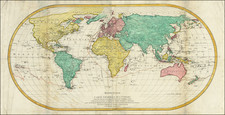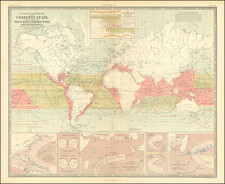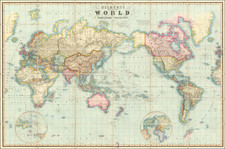The Ulm Ptolemy World Map -- First World Map Printed North of the Alps and First To Appear in Original Color
Finely colored example of the Ulm Ptolemy map of the world, perhaps the most famous and highly sought of all fifteenth-century world maps and certainly the most decorative.
The Ulm edition of Ptolemy's Geographia, which included this iconic pre-Columbian map of the world, was first published in 1482 by Lienhart Holle. This is the first map of the world printed north of the Alps and the first to appear in color applied by the publisher and the first to show modern discoveries not described by Ptolemy. In contrast to the two previous illustrated editions - Bologna (1477) and Rome (1478) - the maps in the Ulm edition are woodblock prints, not copperplate engravings. This is also the earliest world map signed by its engraver, Johanne Schnitzer. Schnitzer, also known as Johann the blockcutter, came from Armsheim, Germany. While this map is signed, others of his are not but can be identified by the backwards capital 'N' which he reverses in his woodcuts.
The maps in the Ulm edition were drawn from the manuscript maps of Donnus Nicolaus Germanus, a Benedictine monk from Breslau who produced brilliant presentation examples of Ptolemy's Geographia for Italian bibliophiles in the 1460s and 1470s. Specifically, the 1482 Ulm was patterned after the manuscript atlas prepared by Germanus for Pope Paul II.
While Ptolemaic in its basic construction, the Ulm world map includes more recent information in Scandinavia, based upon Claudius Clavius's map of 1427. In addition, the map includes the earliest printed depiction of the Polar Seas (Mare Glaciale) and "Glacias" (also referenced at "Glacialis Insula" in late 15th centuries texts), which some commentators have identified as an unknown Arctic Land (Sigurðsson 1971, 83–84). Curiously however, the Portuguese discoveries in Africa are omitted. The map retains a closed Indian Ocean, with a land bridge or unknown Southern Continent connecting Asia and Africa. Twelve wind-heads ring the map, each of which is named.
The Ulm Ptolemy was the first book Holle published, but it was also to be one of his last. Holle went bankrupt shortly after the original publication. The work was then taken over by Johann Reger, who issued another edition in 1486. The brilliant blue of the 1482 maps, made from crushed lapis lazuli, was replaced by a brown color in the 1486 making the 1482 copies beautifully distinct.
The Ulm Ptolemy of 1482 and 1486
The Ulm edition of Ptolemy was first published in 1482 by Lienhart Holle. In contrast to the two earlier illustrated editions of Ptolemy's geography - Bologna (1477) and Rome (1478) - the maps in the Ulm edition are woodblock prints, not copperplate engravings. The maps in the Ulm edition follow the manuscript maps of Donnus Nicolaus Germanus, a Benedictine monk from Breslau who produced brilliant presentation copies for Italian elites in the 1460s and 1470s. Specifically, the Ulm was patterned after the manuscript atlas prepared for Pope Paul II. The Ulm Ptolemy was the first book Holle published, but it was also to be one of his last. Holle went bankrupt shortly after the original publication. The work was then taken over by Johann Reger, who issued another edition in 1486.
The differences between the two editions are relatively small. The 1486 maps typically include titles at the top, whereas there were no titles on the 1482 maps. An unpublished study of the individual maps reveals that there are multiple states of most of the maps.
It had long been suggested that the way to differentiate between the 1482 and 1486 editions was the use of lapis lazuli blue in the 1482 edition for the seas, whereas the 1486 used brown. However, the same unpublished study, which evaluated dozens of examples of the two editions, determined that the earliest examples of the 1486 were also issued with the lapis lazuli blue, suggesting that when Johann Reger acquired the woodblocks, he likely also acquired some unused lapis lazuli. In 2021, we offered for sale a complete example of a 1486 entirely in lapis lazuli blue.
Claudius Ptolemy (fl. AD 127-145) was an ancient geographer, astronomer, and mathematician. He is known today through translations and transcriptions of his work, but little is known about his life besides his residence in Alexandria.
Several of his works are still known today, although they have passed through several alterations and languages over the centuries. The Almagest, in thirteen books, discusses astronomy. It is in the Almagest that Ptolemy postulates his geocentric universe. His geometric ideas are contained in the Analemma, and his optical ideas were presented in five books known as the Optica.
His geographic and cartographic work was immensely influential. In the Planisphaerium, Ptolemy discusses the stereographic projection. Perhaps his best-known work is his Geographia, in eight books. However, Ptolemy’s ideas had been absent from western European intellectual history for roughly a thousand years, although Arab scholars interacted with his ideas from the ninth century onward.
In 1295, a Greek monk found a copy of Geographia in Constantinople; the emperor ordered a copy made and the Greek text began to circulate in eastern Europe. In 1393, a Byzantine diplomat brought a copy of the Geographia to Italy, where it was translated into Latin in 1406 and called the Cosmographia. The manuscript maps were first recorded in 1415. These manuscripts, of which there are over eighty extant today, are the descendants of Ptolemy’s work and a now-lost atlas consisting of a world map and 26 regional maps.
When Ptolemy’s work was re-introduced to Western scholarship, it proved radically influential for the understanding and appearance of maps. Ptolemy employs the concept of a graticule, uses latitude and longitude, and orients his maps to the north—concepts we take for granted today. The Geographia’s text is concerned with three main issues with regard to geography: the size and shape of the earth; map projection, i.e. how to represent the world’s curve proportionally on a plane surface; and the corruption of spatial data as it transfers from source to source. The text also contains instructions as to how to map the world on a globe or a plane surface, complete with the only set of geographic coordinates (8000 toponyms, 6400 with coordinates) to survive from the classical world.









![La Carte Generale du Monde. dressée sur les Relations les plus recentes. Par P: Du Val [General Map of the World, Based on the Most Recent Observations. By P. Du Val]](https://storage.googleapis.com/raremaps/img/small/95625.jpg)
![Historiarum Indicarum Libri XVI [with:] Indiarum Orientalium Occidentaliumque Descriptio. Pet. Maffei Historiae Harum Verissimae, Dedicata.](https://storage.googleapis.com/raremaps/img/small/102793.jpg)
![[ WWI Anti-German Propaganda ] Le Plan Pangermaniste](https://storage.googleapis.com/raremaps/img/small/63622.jpg)


